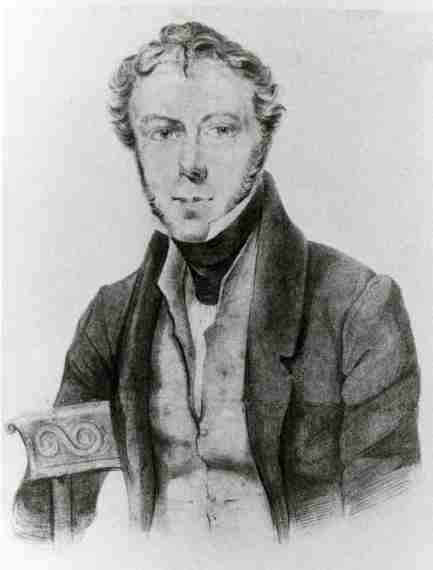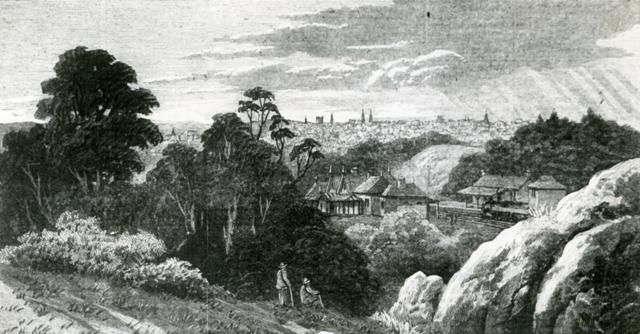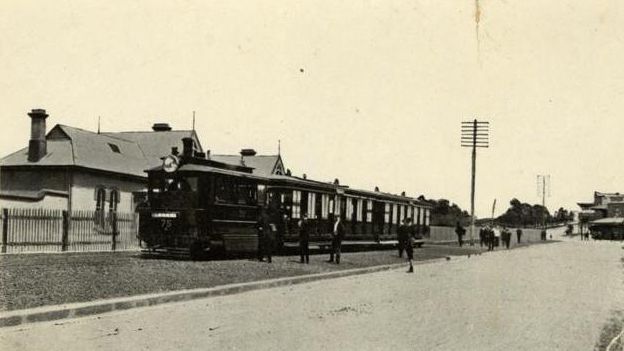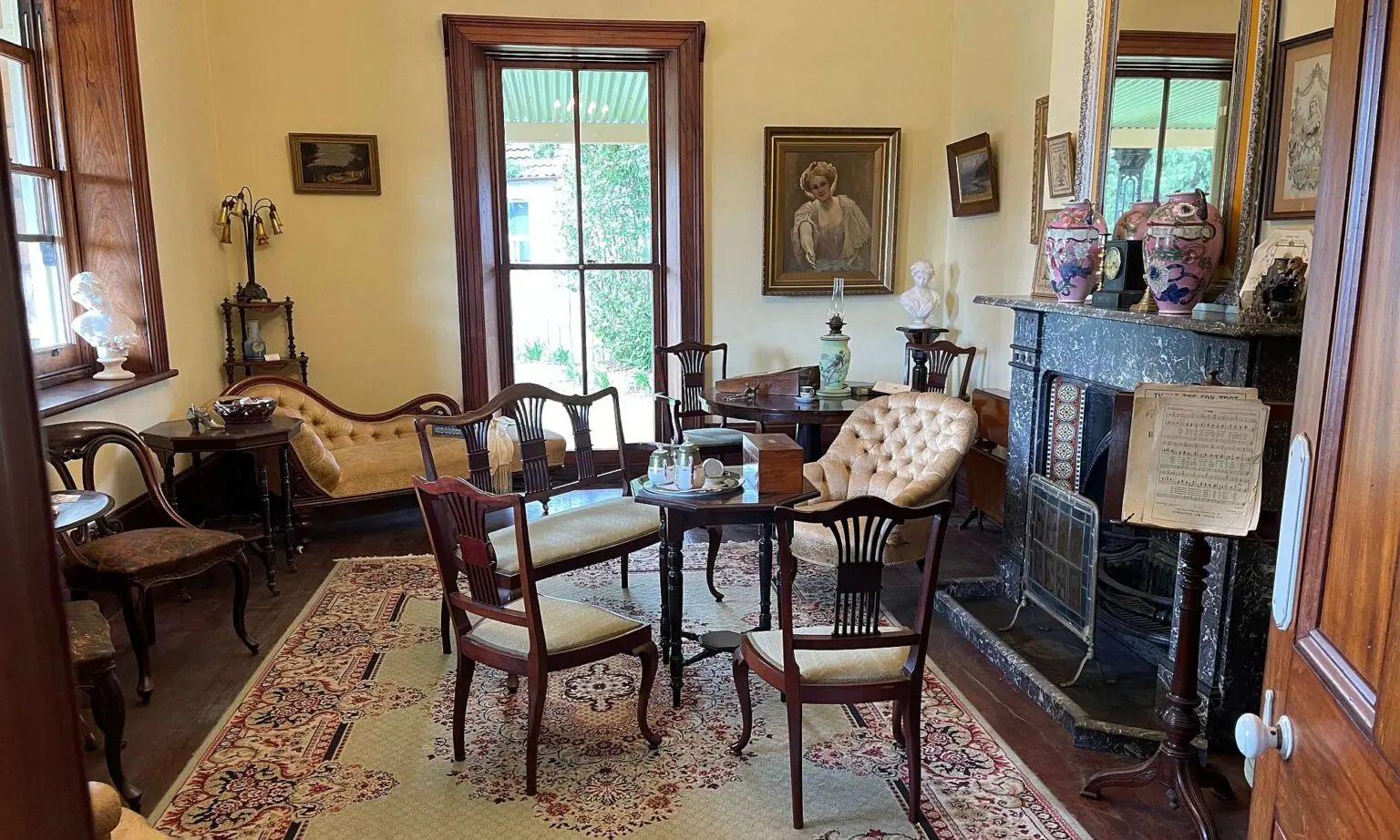by Gifford and Eileen Eardley
Gazing upon the Arncliffe scene, in this year of grace, southwards from Cooks River bridge at Tempe, it is difficult to envisage the general appearance of the area prior to the advent of settlement. The river was fringed with a dense growth of mangroves and the marshy tracts bordering the stream were covered with sombre hued she-oaks, or casuarina trees. In the background rose forested hill country with a steep-sided rocky escarpment encircling each of the numerous ridges, on which flourished age-old angophora trees, each with its own grotesque form of trunk sculpture. Kangaroos and wallabies abounded throughout this sylvan wilderness and, even today, something of the former variety of birdlife is to be seen amongst the reeds and bushland surrounding untouched margins of the nearby Wolli Creek.

Aboriginal tribes banqueted on the rich supply of cockles, mussels, oysters, and other shell-fish, obtained by the womenfolk from the salt mudflats. Traces of long abandoned “kitchen middens”, as their camp refuse heaps are named, can be discerned at the foot of “Nanny Goat” hill, immediately west of Turrella Railway Station, and also at the high northern end of Hill Street, Arncliffe, there is an old feasting ground at a spot ostensibly used as a “lookout” against possible raiding parties. From the native point of view this certainly was a land of plenty, insofar as food supplies were concerned, and numerous caves in the sandstone terrain adequately provided for their shelter.
The vast area contained between Cooks and Georges rivers, and extending westward to Salt Pan Creek was, according to a map of the 1815 period, named Botany Bay. At this time civilised settlement was indeed sparse and amongst the very first settlers, to what is now known as Arncliffe, came Reuben Hannam who gained a grant of 100 acres ranged along the southern bank of Wolli Creek. On this property a small two-roomed stone cottage was erected, which survived until about 1928 when it was demolished to make way for the construction of the East Hills Railway. It is possible that this tiny residence could have been the first homestead immediately south of Cooks River insofar as Arncliffe is concerned. Reuben Hannam was overseer at the Government brickworks located on Brickfield Hill, the site of which, according to tradition, being now occupied by the firm of Anthony Hordern and Sons.

About 1828 Mr. Alexander Spark, a Sydney business man, established his country residence, named “Tempe”, on the south bank of Cooks River where the stream narrowed to pass between two opposing sandstone hillocks, before entering the wide expanse of estuarine mangrove covered mudflats, through which the tidal channels, in great meanders, flowed slowly to Botany Bay. Mr. Spark’s property, owing to its pleasant surroundings and good husbandry, became one of the show-places of Sydney-town, but eventually evil times beset its owner and the extensive grounds had to be subdivided into small allotments and farm sites, clustered together under the place name of Tempe. The house survived this vicissitude and has been for many years in the keeping of the good sisters associated with St. Magdalen’s Training Centre.

Another early settler was David Hannam, son of the aforementioned Reuben Hannam, who was successful in obtaining a 60-acre grant immediately south of the Spark’s property, the land spreading over the northern slopes of what is now called Arncliffe Hill. David Hannam built his homestead, which eventually became known as “Arncliffe” (after a place-name in Yorkshire) at the eastern side of Eden Street, just south of the intersection of Burrows Street. Incidentally Eden Street was formerly named Old Rocky Point Road, being portion of the original highway to Sans Souci, via Rockdale and old-time Kogarah township.
It will be noted that the area now known as Arncliffe was divided into a series of extensive allotments when the original land grants were made, and it was not until these properties were subdivided, and connecting streets formed, that the village began to develop. A number of the inhabitants were self-contained and grew their own vegetables and fruit trees and, of course, kept fowls, ducks, and sometimes a pig. Many of the homes were made of brick, with slate roofing, and their gardens were protected from roaming cattle, and goats, by wooden paling fences. The majority of these houses are still occupied and most are kept in excellent order. They were somewhat plain in their design and generally decorated by means of cast-iron fringing, of oftimes elaborate pattern, affixed beneath the lower edge of the front verandah support beams. This fringing, was picked out in all manner of colours which gave a gay effect, one would like to see a renewal of this old-time custom.
The first main road, little more than a track wending its way through bushland, became known as the Rocky Point Road, and passed over the low salt swamp, adjacent to Cooks River, by means of an embankment, and a short log bridge, before curving southwestwards to climb the northern slopes of Arncliffe Hill, following, as aforementioned, the alignment of the present Eden Street. Reaching the lowest point of the ridge, located where Firth Street joins Forest Road, the original highway curved eastward and then southward in its descent to the Spring Creek Valley, running against and on the western side of the Princes Highway until Spring Street was reached, where both the old and the new main roads united to follow the same alignment southwards to Rockdale and beyond. The steep down grade south of the Forest Road intersection became known locally as Cobblers Pinch and proved a terror to the drivers of horse drawn vehicles, so much so that in 1864, this portion of the old road was abandoned when the present main road, now called Princes Highway, was constructed.
A second main road was constructed in the mid 1840s, which left Rocky Point Road in the vicinity of Allen Street and, in a series of shallow curves that avoided the marsh foreshores, passed westward to join with the present Wollongong Road in the vicinity of Almond Street. Here the road swerved to avoid a rocky knoll and reached Barden’s Public House at the north-western corner of Kelsey Street. The road then curved slightly westward to pass near a freshwater creek, obviously for watering purposes, after which it wound its way along the lower western side of Arncliffe Hill to reach the intersection of the later constructed Forest Road, continuing along the top level of the watershed until it reached Peakhurst. Here it descended to the punt crossing at Lugarno.
The third main road of consequence was the Muddy Creek Road, later termed West Botany Street, which gave an easier approach to the farmers and settlers in the West Botany District, east of Rockdale. This was a region of vegetable gardens, poultry farms, and pig raising pens, which were scattered amidst the drier parts of Patmores Swamp.
One of the principal industries of the early days was limeburning, the basic material being dredged from the huge deposits of shells found in the bed of Cooks River. Special kilns were built along the river shore in which the shells were placed in layers, resting on alternate beds of wood fuel. The resultant quick- lime was in great demand for the making of mortar used in the laying of stones and bricks for the building trade. The burning of mangrove tree trunks was also carried out to gain supplies of soda-ash used in the making of soap and also glass. The vast forests afforded plentiful supplies of firewood, which was taken in horse-drawn vehicles of all descriptions, to the metropolis, where it was used for the purpose of heating and cooking. Once the land became cleared of its trees and undergrowth it was utilised for grazing of cattle, horses, and goats, while the more fertile bottoms, after draining, were converted into vegetable gardens and orchards. A certain amount of dairying was also carried out, whilst boiling-down works and tanneries in the district gave immediate neighbours much cause for complaint.

In the early days places of worship were few and far between. In the 1860s St. Davids Church of England, now classified as Old St. Davids, was built in Hirst Street. This small historic edifice was erected largely through the efforts of Mary Hannam in memory of her husband, hence the name St. Davids. Additions to the old church were made in later years and the fabric is maintained in excellent condition and Sunday services are still held therein. The Congregationalists met in the house, named Hillside, belonging to Mr. Favell, situated at the junction of Wolli and Bardwell Creeks, the latter being then known as Stoney Creek. It has been said that people came to “Hillside” for the service by rowing boat along the reed-fringed Wolli Creek. Then there was a Primitive Methodist meeting house, a small brick building built, according to local information, by a Mr. Nelson who resided in Arncliffe Street, immediately opposite his church. With the Union of the Wesleyan and other Methodist Churches throughout the State, an important event which took place just after the turn of the century, this tiny church was vacated insofar as worship was concerned and it was not long before Chinese tenants moved in and the place became the living quarters of the Celestials engaged in market gardening. About 1960 this then dilapidated building was demolished to make way for factory premises.
The oldest public school in the St. George District was founded at Arncliffe during November, 1861, when Mr. George Turner became responsible for the education of some thirty pupils. The school house, so it is stated, was a slab-sided building that had been provided with four forms for seating purposes, but little else in the way of teaching equipment. It is unfortunate that the exact location of this school appears to have escaped historians and further research is necessary in this direction. The original school closed in January 1863, and it was not until about the middle of the year 1868 that Mr. John Mills opened a second school, which, according to Mr. Phillip Geeves, “was held in a room which had three walls of stone and one of slab. For furniture church seats were used”. Through lack of attendance this school closed in 1873. Again the exact site does not appear to be known. The original building of the present Arncliffe School, formerly known as West Botany, came into use during July 1880, under the control of Mr. W. T. B. Bateson, who had an initial enrolment of twenty-seven pupils. Since this small beginning the Arncliffe School has grown into a fine institution, replete with many educational facilities which are housed in well designed buildings at the crest of Arncliffe Hill.
The opening of the first section of the Illawarra Railway, between Sydney and Hurstville, took place on October 15, 1884, and was responsible for a spate of housing allotment subdivisions. Streets were formed in all directions, many of very narrow width, and Arncliffe quickly lost its rural atmosphere and became a populous suburb. Small shopping centres became scattered here and there along the highways, and also at the railway station precincts, whilst the “corner shop”, well stocked with essential commodities, flourished throughout the area. These latter emporiums, the bug-bear of enthusiastic but unrealistic town planners, are also well stocked with local gossip and the happenings in detail of the nearby community.

Another epoch in the history of Arncliffe was the opening, on October 13, 1909, of a steam tramway to Bexley. This system, in its planning stage, was to have formed portion of a grandiose scheme of cross-country lines linking both the Sydney Tramways and the Kogarah to Sans Souci Tramway. However, this extensive plan was shelved by reason of its cost. The Bexley service proved unremunerative, largely, so it has been claimed, to the outmoded accounting procedure adopted by the Tramway Department. Uncontrolled bus competition forced its closure on December 31, 1926.

It is only in comparatively recent years that the industrial development on the Arncliffe flat lands commenced. Practically all of the once fertile vegetable gardens have been devastated to provide factory sites. However, the suburb is fortunate in preserving its southern precincts as a residential area, in which there are many fine homes of historic interest.
Images courtesy of the Bayside Library Service Local History Collection.
This article was first published in the April 1966 edition of our magazine.
Browse the magazine archive.

